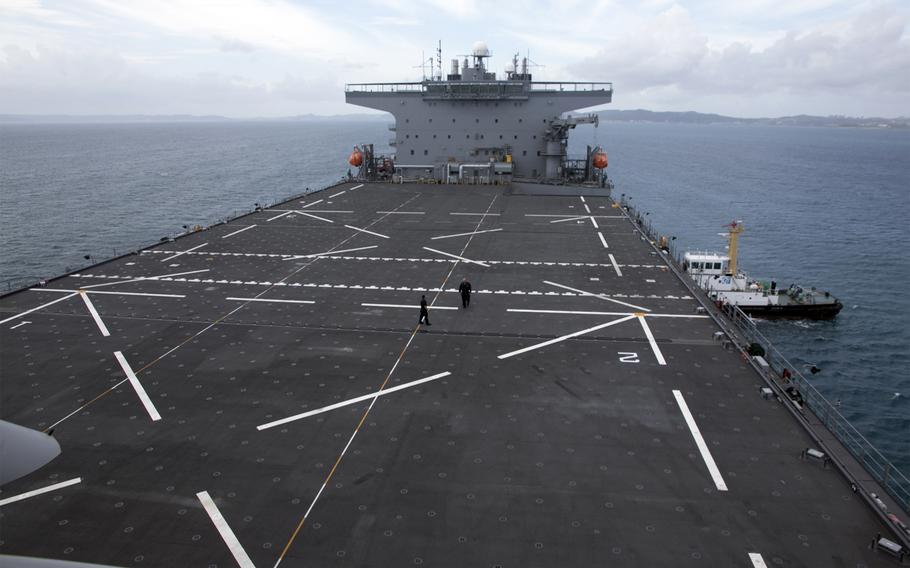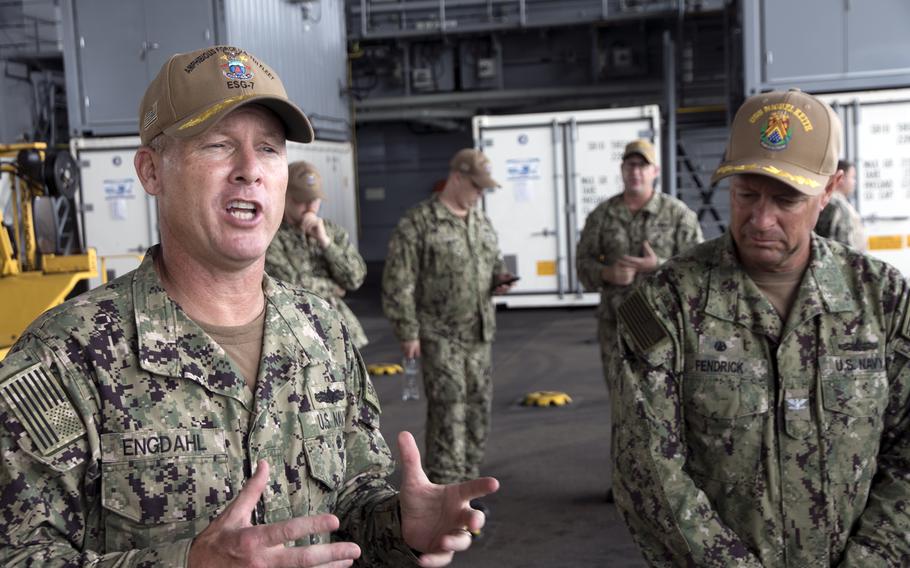
The USS Miguel Keith's flight deck has space for four helicopters at a time and separates the forward and aft deckhouses. (Matthew M. Burke/Stars and Stripes)
WHITE BEACH NAVAL FACILITY, Okinawa – The newest addition to the 7th Fleet is a customizable command-and-control vessel that recently arrived on Okinawa to give Navy and Marine commanders a look at its capabilities.
The USS Miguel Keith – a Lewis B. Puller-class expeditionary staging base – pulled into White Beach Naval Facility on Oct. 5 and was open to tours by officers of the 7th Fleet and III Marine Expeditionary Force who may one day put the ship to work during humanitarian crises or in battle.
The Miguel Keith has the third-largest flight deck in the fleet and will remain in the Indo-Pacific for the foreseeable future, executive officer Cmdr. Marty Blomberg said during a tour Wednesday.
The ship can be modified to fit each mission with interchangeable shipping containers that can be turned into anything from berthing for special operations troops to showers, cold storage and laundry facilities. It can also launch helicopters and small boats.
“This ship brings remarkable humanitarian assistance/disaster response capabilities,” Expeditionary Strike Group 7 commander Rear Adm. Chris Engdahl said in an interview Wednesday on the ship’s expansive mission deck, an open space below the flight deck designed for storing equipment and launching boats.
“The flight deck has great potential,” he said.

The commander of Expeditionary Strike Group 7, Rear Adm. Chris Engdahl, left, and the USS Miguel Keith's skipper, Capt. Troy Fendrick, speak to reporters from the ship's mission deck at White Beach Naval Facility, Okinawa, Oct. 6, 2021. (Matthew M. Burke/Stars and Stripes)
San Diego-based General Dynamics National Steel and Shipbuilding Co. started work on the Miguel Keith in January 2018. It is the third Puller-class ship, after the USS Hershel "Woody" Williams, and was commissioned May 8.
The ship’s homeport is Saipan, but only on paper, Blomberg said. It will likely move around the region.
The ship bears the name of Medal of Honor recipient Marine Lance Cpl. Miguel Keith, who died attacking an overwhelming enemy force in Quang Ngai province in 1970 during the Vietnam War.
It was built with four core capabilities in mind: aviation, habitability, staging and command and control, ship commander Capt. Troy Fendrick said Wednesday.
“So, from that aspect you can think of it as a floating staging base for numerous missions,” he said.
The flight deck has space for four helicopters at a time and separates the forward and aft deckhouses.
The aft deckhouse is home to about 40 civilian mariners who are responsible for engineering and navigation. The forward deckhouse is home to a Navy crew of about 100, which rotates in “blue” and “gold” teams from San Diego on five-month deployments. Fendrick goes back and forth between the two, Blomberg said.
The ship has a hangar for maintenance on the largest helicopters, but no well deck, so it carries no hovercraft or larger boats. The ship is not built to accommodate short-takeoff and vertical-landing F-35B joint strike fighters.
The civilians and sailors collaborate with one another in deck operations and back each other up in damage control, for example.
“They’ve got their own supply; they’ve got their own food,” Blomberg said. “It’s almost like a different ship.”
The civilian mariners have friers in their galley, whereas the sailors do not, so the civilians have better French fries, he said jokingly.
“We share responsibilities; we communicate openly with them,” command Master Chief Suxuan Oonyu said. “It’s actually a very good relationship and that’s probably a key to our success in many ways.”
Both Oonyu and Fendrick said a ship operated by professional civilian mariners has distinct advantages. For example, the uniformed sailors aren’t under the pressure of getting subordinates or new arrivals up to speed on navigation; instead, they can focus on military operations.
“Half of my crew, this may be their first tour,” Blomberg said. The civilian mariners “all have way more experience. We learn from them.”